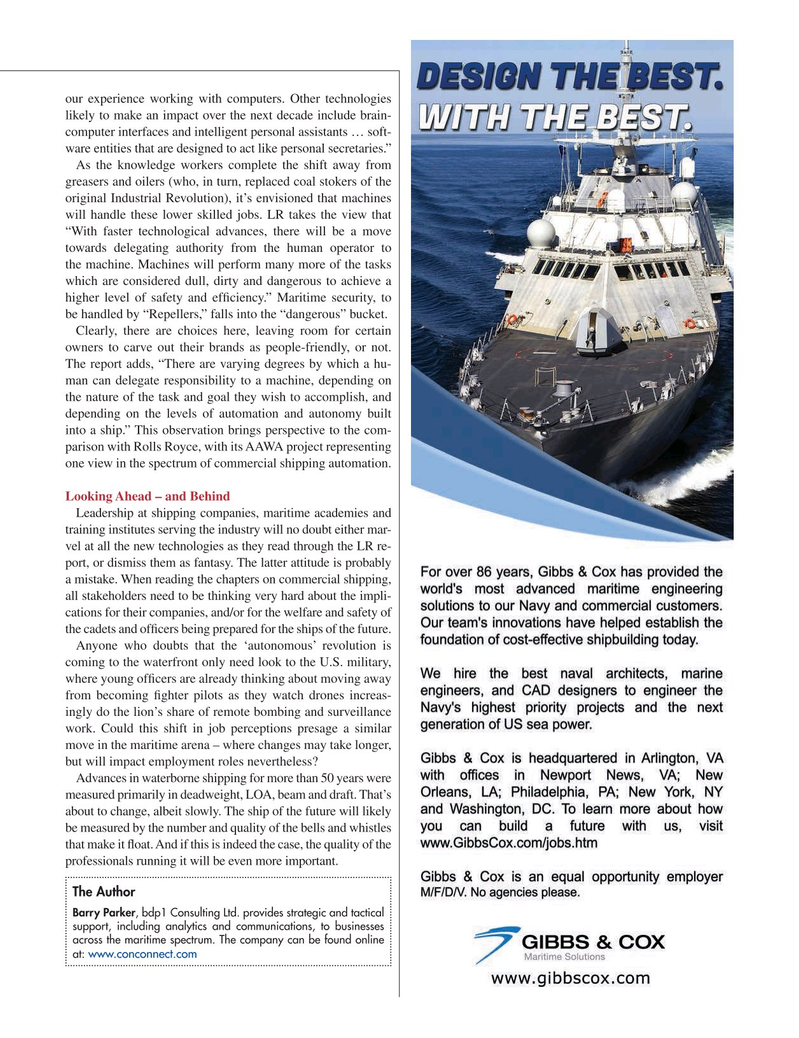
Page 17: of Maritime Logistics Professional Magazine (Q3 2015)
Read this page in Pdf, Flash or Html5 edition of Q3 2015 Maritime Logistics Professional Magazine
our experience working with computers. Other technologies likely to make an impact over the next decade include brain- computer interfaces and intelligent personal assistants … soft- ware entities that are designed to act like personal secretaries.”
As the knowledge workers complete the shift away from greasers and oilers (who, in turn, replaced coal stokers of the original Industrial Revolution), it’s envisioned that machines will handle these lower skilled jobs. LR takes the view that “With faster technological advances, there will be a move towards delegating authority from the human operator to the machine. Machines will perform many more of the tasks which are considered dull, dirty and dangerous to achieve a higher level of safety and ef? ciency.” Maritime security, to be handled by “Repellers,” falls into the “dangerous” bucket.
Clearly, there are choices here, leaving room for certain owners to carve out their brands as people-friendly, or not.
The report adds, “There are varying degrees by which a hu- man can delegate responsibility to a machine, depending on the nature of the task and goal they wish to accomplish, and depending on the levels of automation and autonomy built into a ship.” This observation brings perspective to the com- parison with Rolls Royce, with its AAWA project representing one view in the spectrum of commercial shipping automation.
Looking Ahead – and Behind
Leadership at shipping companies, maritime academies and training institutes serving the industry will no doubt either mar- vel at all the new technologies as they read through the LR re- port, or dismiss them as fantasy. The latter attitude is probably a mistake. When reading the chapters on commercial shipping, all stakeholders need to be thinking very hard about the impli- cations for their companies, and/or for the welfare and safety of the cadets and of? cers being prepared for the ships of the future.
Anyone who doubts that the ‘autonomous’ revolution is coming to the waterfront only need look to the U.S. military, where young of? cers are already thinking about moving away from becoming ? ghter pilots as they watch drones increas- ingly do the lion’s share of remote bombing and surveillance work. Could this shift in job perceptions presage a similar move in the maritime arena – where changes may take longer, but will impact employment roles nevertheless?
Advances in waterborne shipping for more than 50 years were measured primarily in deadweight, LOA, beam and draft. That’s about to change, albeit slowly. The ship of the future will likely be measured by the number and quality of the bells and whistles that make it ? oat. And if this is indeed the case, the quality of the professionals running it will be even more important.
The Author
Barry Parker, bdp1 Consulting Ltd. provides strategic and tactical support, including analytics and communications, to businesses across the maritime spectrum. The company can be found online www.conconnect.com at: 1-17 Q3 MP2015.indd 17 9/18/2015 3:41:20 PM

 16
16

 18
18
